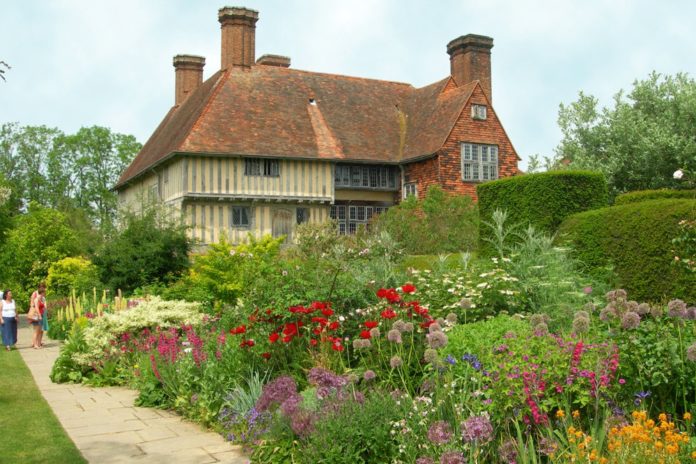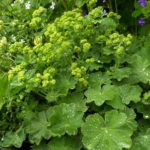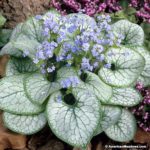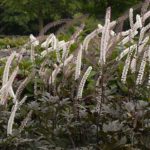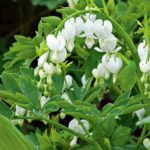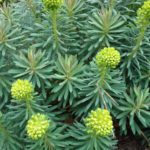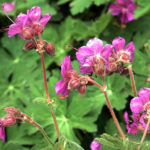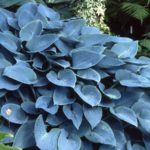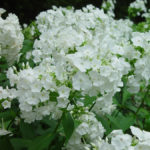1Alchemilla mollis
Alchemilla mollis (Lady’s mantle)
All the great cottage gardens of England have this old-fashioned favorite. It is loved for the way it displays raindrops like diamonds on its rough, hairy leaves. It is also valued for the lime green color and frothy texture of its effervescent sprays of flowers, which first appear in June and last for several weeks. No garden should be without it. The name Alchemilla is rooted in the word alchemy. When the plant was used as an herb it was thought to possess magical healing properties. The word mollis refers to the soft hairs of the leaves, which lock together in a way that looks rather like a lady’s cloak or mantle. Size: 12 to 14 inches (30 to 35 cm). Flowering: May to June
2Brunnera ‘Jack Frost’
Brunnera macrophylla ‘Jack Frost’ (Siberian bugloss)
Once in a while a new cultivar comes along that really lives up to its name as a top-of-the-class introduction. That is the case with Brunnera macrophylla ‘Jack Frost’. Not all new hybrids live up to the hoopla that surrounds them, but ‘Jack Frost’ turned out to be a truly reliable, first-rate perennial for the woodland or shade garden and not just a flash in the pan. What makes it special is its delightful foliage: beautiful, heart-shaped, silver leaves with delicate green veins. That would be enough, but this plant offers the added bonus of gorgeous flowers. In mid-spring, it produces dainty blue forget-me-not-like flowers and when these fade the leaves plump up in size quite noticeably and become even more expressive. Size: 12 to 14 inches (30 to 35 cm). Flowering: April
3 Cimicifuga ‘Brunette’
Cimicifuga simplex ‘Brunette’ (Black-leaved bugbane)
This has fabulous dark black-purple foliage and arching stems bearing white bottlebrush flowers with a light purple tint. The dark foliage is the perfect foil for the hot colors of canna lilies or for contrast against the golden yellow leaves of hostas. And cimicifuga’s white flowers are a welcome arrival, waving at the top of 6- or 7-foot (1.8- to 2.1-m) stems at the end of summer, usually in September. It is also an extremely adaptable plant, flourishing in a variety of situations and behaving consistently, with near indifference to soil conditions. A lot of gardeners first got to know cimicifuga through the cultivar ‘Atropurpurea’, which also has dark foliage, but once they meet ‘Brunette’, there is no going back. ‘Hillside Black Beauty’ has even darker purple foliage
4Dicentra spectabilis ‘Alba’
Dicentra spectabilis ‘Alba’ (Old-fashioned bleeding heart)
Few spring flowers can compare with the transcendent, classical beauty of old-fashioned bleeding heart. It has such a simple, elegant, graceful appearance and exquisite white or red blooms. It is easy to understand why it has been a favourite of gardeners for generations. The heart-shaped flowers are suspended individually like precious lockets along gently arching stems that reach out romantically from a lush clump of soft green leaves. If the outer petals of a single flower are carefully removed, a perfectly formed, miniature Valentine’s Day heart can be found in the center. The plant derives its common name from the appearance of the red form of Dicentra spectabilis, which has tiny, heart-shaped inner petals enclosed by red outer petals. Size: 3 feet (90 cm).
5Euphorbia characias wulfenii
Euphorbia characias wulfenii (spurge)
A stately member of the spurge family, this majestic evergreen sends up graceful, spear-shaped, blue-green leaves and produces sturdy flower stems with large lime-green, multi-eyed flower heads in spring. Evergreen in most zone 7 gardens, it is a fairly large, bulky specimen, quickly growing 4 feet high and wide (1.2 by 1.2 m) within a couple of years. It is, however, extremely well-behaved. Its sturdy stems can be trimmed easily, making it manageable. One of the workhorses of the garden, it holds its form beautifully in all weather, providing dependable structure, stability, consistent foliage color and a touch of drama throughout the seasons. Size: 4 feet (1.2 m). Flowering time: March to May.
6Geranium macrorrhizum ‘Bevan’s Variety’
Geranium macrorrhizum ‘Bevan’s Variety’ (cranesbill, hardy geranium)
Cranesbills are real geraniums. The plants many people call geraniums are not geraniums at all–they are pelargoniums. These true geraniums are tough, winter-resistant plants with tiny, exquisite flowers that come in a delicious range of colours from sky blue to candy pink, royal purple to milk white. My No.1 pick is ‘Bevan’s Variety’. Not only is this a compact, low-growing plant, it produces lovely magenta-pink flowers in spring and has fragrant-to-the-touch foliage that in most coastal gardens stays evergreen all year round, making an excellent groundcover. If you don’t like magenta-pink, there is a white-flowered form, ‘Alba’, and ‘Ingwersen’s Variety’, which has a more purplish-pink flower. Size: 8 to 10 inches (20 to 25 cm).Flowering: April to May.
7Hosta ‘Halcyon’ (plantain lily)
Hosta ‘Halcyon’ (plantain lily)
Hostas are so dependable, versatile and long lasting, it is no surprise so many gardeners regard them as the perfect perennial. They are certainly one of the indispensable structural plants of the shade garden.They come in an astonishing range of colour, size and shape, but the blue-leafed varieties always strike me as the most attractive.‘Halcyon’ is classified as a groundcover-type because it is so low-growing and manageable. Other great blues are ‘Hadspen Blue’, ‘Blue Angel’, ‘Blue Dimples’, ‘Blue Wedgewood’, ‘Blue Moon’, ‘Blue Cadet’ and ‘Blue Boy’. Yellow leafed varieties are another firm favourite, including ‘Piedmont Gold’, ‘Sun Power’, ‘Midas Touch’ and ‘August Moon’. Size: 12 to 16 inches (30 to 40 cm). Flowering: July.
8Ligularia ‘Desdemona’
Ligularia dentata ‘Desdemona’ (ligularia, elegant ears)
This plant is valuable because it makes such a long contribution, rising early in spring to produce fabulous, dark purple-green leaves and then producing bright, golden-yellow, star-shaped flowers that give a needed lift of colour just when things are starting to flag in August. ‘Desdemona’ has an attractive cousin, ‘Othello’, which to the casual observer is identical. The difference is that ‘Othello’ has slightly darker leaves and tends to bloom a little earlier. The Ligularia family has one other star: L. stenocephala ‘The Rocket’, which produces soaring yellow-gold flower spikes. Both ‘Desdemona’ and ‘The Rocket’ offer strong architectural interest in the garden as well as eye-catching flowers.Size: 4 to 6 feet (1.2 to 1.8 m). Flowering: June to July.
9Sedum ‘Autum Joy’
Sedum x ‘Autumn Joy’ (showy stonecrop)
Of all the drought-tolerant plants, sedum is one of the most reliable and popular. And of all the sedums, the sturdy, upright, late-blooming forms are perfect picks for the perennial border. ‘Autumn Joy’ is top of the class. It shows its value in the garden from the first moment it appears in spring to the end of fall when its sturdy, broccoli-shaped flower heads hang on defiantly even in heavy frost. Perennial borders are often anchored at the corners with clumps of ‘Autumn Joy’. It certainly lives up to its name. It develops steadily through the summer, growing thick, fleshy, succulent leaves on erect stems. By August, it will have formed large, attractive, flat-topped flower heads that not only offer a pleasing texture in the border, but provide vital fall colour and impressive architectural structure Size: 2 feet (60 cm). Flowering: August to September.
10Phlox ‘David’
Phlox paniculata ‘David’ (garden phlox)
You know summer is at its peak when you see tall, majestic clumps of Phlox paniculata holding up spectacular, sweetly scented panicles of bright red, white, pink and purple flowers. It is an understatement to say phlox is a stalwart of the summer garden. It is much more. It is one of the plants you cannot do without if you want to lift your garden in July and August to perfection. There are many excellent varieties but my favourite is ‘David’, a superb, mildly fragrant white cultivar that also just happens to be resistant to mildew. If you want more colour, try ‘Starfire’ (cherry red), ‘Amethyst’ (lavender-violet), ‘Elizabeth Arden’ (pink), ‘Eva Cullum’ (pink with purple eye) or ‘Bright Eyes’ (pink with a cerise eye). Size: 3 to 4 feet (90 cm to 1.2 m). Flowering: July to August.
